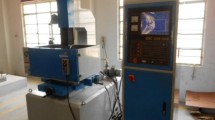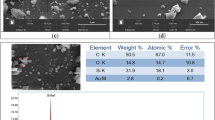Abstract
In this paper, the investigational work is carried out on the micro reciprocated wire electrical discharge machining (wire-EDM) of SKD11 using circularly travelled wire with Φ30 μm as tool electrode, aiming to achieve the fabrication of micro parts with high cost-effect, efficiency and precision. The experiments are systematically performed using central composite design approach of response surface methodology to study the effect of open voltage, discharge capacitance, pulse duration and feed rate on material removal rate (MRR) and machining gap. The mathematical models of MRR and machining gap are developed by analysis of variance, and whilst verified by confirmation experiments with ≤ 8.38% and 6.70% prediction errors for MRR and machining gap, respectively. Besides, multi-objective optimization of parameter combinations is attempted by non-dominated sorting genetic algorithm-II. Finally, a typical experimental sample, micro gear is successfully machined with 1194.38 μm tip diameter under the condition of No. 14 optimal solution.














Similar content being viewed by others
Abbreviations
- U :
-
Open voltage
- C :
-
Discharge capacitance
- T on :
-
Pulse duration
- F :
-
Feed rate
- T off :
-
Pulse interval
- R :
-
Discharge resistance
References
Ghayesh, M., Farokhi, H., & Amabili, M. (2013). Nonlinear behaviour of electrically actuated MEMS resonators. International Journal of Engineering Science,71, 137–155.
Zhong, J. M., Wu, X. Y., Xu, B., Li, J. B., Luo, F., Cheng, R., et al. (2015). Laminated fabrication of micro-stepped gear mold based on WEDM and thermal diffusion welding. The International Journal of Advanced Manufacturing Technology,78(5–8), 1233–1240.
Li, J. W., Liu, H. X., Shen, Z. B., Qian, Q., Zhang, H. F., & Wang, X. (2016). Formability of micro-gears fabrication in laser dynamic flexible punching. Journal of Materials Processing Technology,234, 131–142.
Zhang, Q., Felder, E., & Bruschi, S. (2009). Evaluation of friction condition in cold forging by using T-shape compression test. Journal of Materials Processing Technology,209(17), 5720–5729.
Pandey, A., & Singh, S. (2010). Current research trends in variants of electrical discharge machining: A review. International Journal of Engineering Science and Technology,2(6), 2172–2191.
Ho, K. H., Newman, S. T., Rahimifard, S., & Allen, R. D. (2004). State of the art in wire electrical discharge machining (WEDM). International Journal of Machine Tools and Manufacture,44(12–13), 1247–1259.
Muthuramalingam, T., & Mohan, B. (2015). A review on influence of electrical process parameters in EDM process. Archives of Civil and Mechanical Engineering,15(1), 87–94.
Park, J. W., Kim, B. H., Ok, J. G., Kim, W. J., Kim, Y. H., & Chu, C. N. (2012). Wire electrical discharge machining of carbon nanofiber mats for field emission. International Journal of Precision Engineering and Manufacturing,13(4), 593–599.
Yilmaz, N. F., & Eyercioglu, O. (2008). An integrated computer-aided decision support system for die stresses and dimensional accuracy of precision forging dies. The International Journal of Advanced Manufacturing Technology,40(9–10), 875–886.
Ming, W., Zhang, Z., Zhang, G., Huang, Y., Guo, J. W., & Chen, Y. (2014). Multi-objective optimization of 3D-surface topography of machining YG15 in WEDM. Materials and Manufacturing Processes,29(5), 514–525.
Zhao, Y., Kunieda, M., & Abe, K. (2014). Study of EDM cutting of single crystal silicon carbide. Precision Engineering,38(1), 92–99.
Ming, W., Zhang, Z., Wang, S. Y., Huang, H., Zhang, Y., & Shen, D. L. (2017). Investigating the energy distribution of workpiece and optimizing process parameters during the EDM of Al6061, Inconel718, and SKD11. The International Journal of Advanced Manufacturing Technology,92(9–12), 4039–4056.
Zheng, J., Lai, X., Zhou, X., Chen, A., & Zheng, W. (2019). Non-pulsed energy modeling based on energy consumption subunits in wire electrical discharge machining (WEDM) process. International Journal of Precision Engineering and Manufacturing,20(5), 853–862.
Sun, Y., Gong, Y., Liu, Y., Cai, M., Ma, X. T., & Li, P. F. (2018). Experimental investigation on effects of machining parameters on the performance of Ti–6Al–4 V micro rotary parts fabricated by LS-WEDT. Archives of Civil and Mechanical Engineering,18(2), 385–400.
Di, S. C., Chu, X. Y., Wei, D. B., Wang, Z. L., Chi, G. X., & Liu, Y. (2009). Analysis of kerf width in micro-WEDM. International Journal of Machine Tools and Manufacture,49(10), 788–792.
Habib, S., & Okada, A. (2015). Experimental investigation on wire vibration during fine wire electrical discharge machining process. The International Journal of Advanced Manufacturing Technology,4(9–12), 2265–2276.
Habib, S., & Okada, A. (2016). Study on the movement of wire electrode during fine wire electrical discharge machining process. Journal of Materials Processing Technology,227, 147–152.
Saha, A., & Mondal, S. C. (2016). Multi-objective optimization in WEDM process of nanostructured hardfacing materials through hybrid techniques. Measurement,94, 46–59.
Khan, I. A., & Tikam, S. R. (2012). Modeling of wire electrical discharge machining of alloy steel (HCHCr). International Journal of Precision Engineering and Manufacturing,13(11), 1989–1995.
Abidi, M. H., Al-Ahmari, A. M., Umer, U., & Rasheed, M. S. (2018). Multi-objective optimization of micro-electrical discharge machining of nickel-titanium-based shape memory alloy using MOGA-II. Measurement,125, 336–349.
Zhenlong, W., Xuesong, G., Guanxin, C., & Yukui, W. (2014). Surface integrity associated with SiC/Al particulate composite by micro-wire electrical discharge machining. Materials and Manufacturing Processes,29(5), 532–539.
Box, G. E. P., & Wilson, K. B. (1992). On the experimental attainment of optimum conditions. Breakthroughs in statistics (pp. 270–310). New York: Springer.
Deb, K., Pratap, A., Agarwal, S., & Meyarivan, T. (2002). A fast and elitist multiobjective genetic algorithm: NSGA-II. IEEE Transactions on Evolutionary Computation,6(2), 182–197.
Guitrau, E. B. (1997). The EDM handbook (pp. 102–105). Cincinnati: Hanser Gardner.
Heo, S., Jeong, Y. H., Min, B. K., & Lee, S. J. (2009). Virtual EDM simulator: Three-dimensional geometric simulation of micro-EDM milling processes. International Journal of Machine Tools and Manufacture,49(12–13), 1029–1034.
Jameson, E. C. (2001). Electrical discharge machining (pp. 82–85). Dearborn: Society of Manufacturing Engineers.
Acknowledgements
This research work is funded by National Natural Science Foundation of China (Grant No. 51675132); Major Project of Applied Technology Research and Development Plan of Heilongjiang Province (Grant No. GA16A404); and National Natural Science Foundation of China (Grant No. 51521003).
Author information
Authors and Affiliations
Corresponding author
Additional information
Publisher's Note
Springer Nature remains neutral with regard to jurisdictional claims in published maps and institutional affiliations.
Rights and permissions
About this article
Cite this article
Chen, X., Wang, Z., Wang, Y. et al. Investigation on MRR and Machining Gap of Micro Reciprocated Wire-EDM for SKD11. Int. J. Precis. Eng. Manuf. 21, 11–22 (2020). https://doi.org/10.1007/s12541-019-00233-7
Received:
Revised:
Accepted:
Published:
Issue Date:
DOI: https://doi.org/10.1007/s12541-019-00233-7




